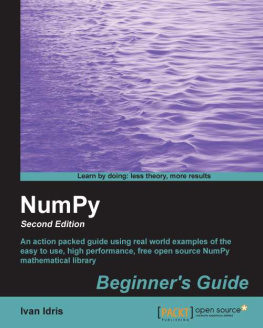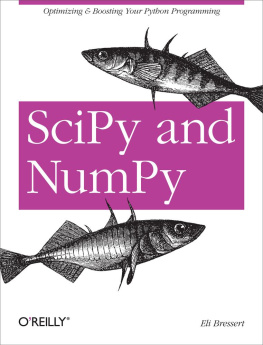Sergio J. Rojas G.
Francisco J. Blanco-Silva
Dr. Robert Clewley
Rahul C. Shah
About the Authors
Sergio J. Rojas G. is currently a full professor of physics at Universidad Simn Bolvar, Venezuela. Regarding his formal studies, in 1991, he earned a BS in physics with his thesis on numerical relativity from the Universidad de Oriente, Estado Sucre, Venezuela, and then, in 1998, he earned a PhD in physics from the Department of Physics at City College of the City University of New York, where he worked on the applications of fluid dynamics in the flow of fluids in porous media, gaining and developing since then a vast experience in programming as an aid to scientific research via Fortran77/90 and C/C++. In 2001, he also earned a master's degree in computational finance from the Oregon Graduate Institute of Science and Technology.
Sergio's teaching activities involve lecturing undergraduate and graduate physics courses at his home university, Universidad Simn Bolvar, Venezuela, including a course on Monte Carlo methods and another on computational finance. His research interests include physics education research, fluid flow in porous media, and the application of the theory of complex systems and statistical mechanics in financial engineering. More recently, Sergio has been involved in machine learning and its applications in science and engineering via the Python programming language.
I am deeply grateful to my mother, Eufemia del Valle Rojas Gonzlez, a beloved woman whose given steps were always in favor of showing and upraising the best of a human being.
Erik A Christensen is a quant analyst/developer in finance and creative industries. He has a PhD from the Technical University of Denmark, with postdoctoral studies at the Levich Institute at the City College of the City University of New York and the Courant Institute of Mathematical Sciences at New York University. His interests in technology span from Python to F# and Cassandra/Spark. He is active in the meet-up communities in London!
I would like to thank my family and friends for their support during this work!
Francisco J. Blanco-Silva is the owner of a scientific consulting companyTizona Scientific Solutionsand adjunct faculty in the Department of Mathematics of the University of South Carolina. He obtained his formal training as an applied mathematician at Purdue University. He enjoys problem solving, learning, and teaching. Being an avid programmer and blogger, when it comes to writing, he relishes finding that common denominator among his passions and skills and making it available to everyone. He coauthored Modeling Nanoscale Imaging in Electron Microscopy , Springer along with Peter Binev, Wolfgang Dahmen, and Thomas Vogt.
About the Reviewers
Dr. Robert Clewley is a polymath scientist and educator. He has been a faculty member at Georgia State University, Atlanta, GA. He specializes in computational and mathematical modeling methods for complex adaptive systems and has published a diverse range of academic journals involving applications in epilepsy, cancer, cardiology, and biomechanics. His research has been supported by federal grants from NSF and the Army Research Laboratory. From the high school level to graduate degree level, he has developed and taught a variety of courses spanning mathematics, computer science, physics, biological sciences, and philosophy of science. Dr. Clewley also develops the open source PyDSTool modeling software that is used internationally in many scientific and engineering fields.
Nicolas Fauchereau is a climate scientist at the National Institute for Water and Atmospheric Research (NIWA Ltd.) based in Auckland, New Zealand.
After obtaining his PhD in France in 2004, he spent 7 years in South Africa working at the University of Cape Town and then at the Council for Scientific and Industrial Research, before joining NIWA in 2012.
He uses statistics, data mining, and machine learning to try and make sense of climate and environmental data and to develop solutions to help people anticipate and adapt to climate variability and change.
He's been using the Python scientific stack for about 10 years and is a passionate advocate for the use of Python in environmental and earth sciences.
A water sports enthusiast, he likes to spend his free time either surfing, kite surfing, or sailing with his wife and two kids.
Valentin Haenel is a software engineer interested in the architectures of high-performance number crunching with Python. Specifically, he is interested in low-level aspects such as interfacing Python with C code, strategies for efficient memory allocation, avoiding redundant memory copies, and exploiting the memory hierarchy for accelerated computation. He spends some of his spare time working on Blosc (http://blosc.org), an extremely fast and multi threaded meta-codec. Occasionally, he flirts with machine learning.
In the past, he had worked on psychophysics data analysis, large-scale brain simulations, analytical engines for business intelligence, and large-scale data-center monitoring. He wrote a book about using the Git version control system and has contributed to a diverse selection of over 50 open source projects. He currently resides in Berlin and works as a freelance software engineer, consultant, and trainer.

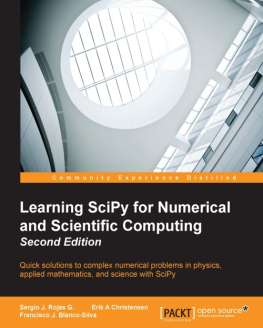

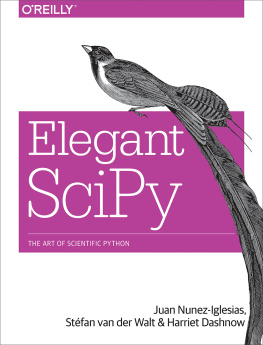
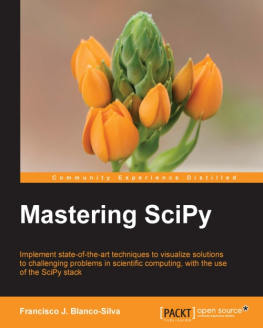
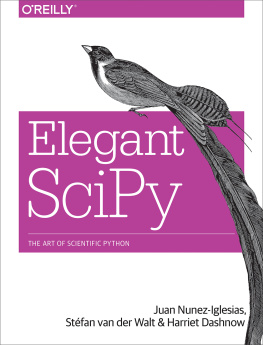
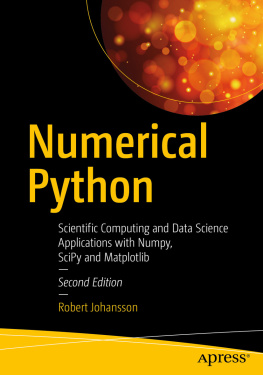
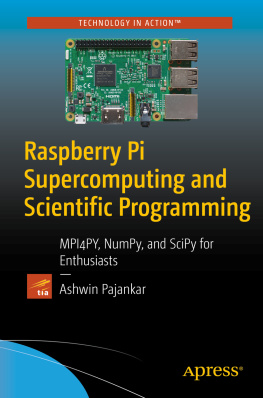
![Eli Bressert [Eli Bressert] - SciPy and NumPy](/uploads/posts/book/119331/thumbs/eli-bressert-eli-bressert-scipy-and-numpy.jpg)

